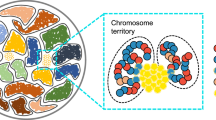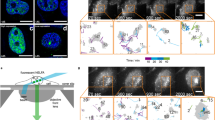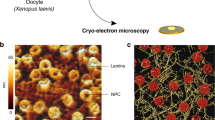Abstract
During a first-order phase transition, an interfacial layer is formed between the coexisting phases and kinetically limits homogeneous nucleation of the new phase in the original phase. This inhibition is commonly alleviated by the presence of impurities, often of unknown origin, that serve as heterogeneous nucleation sites for the transition. Living systems present a theoretical opportunity: the regulated structure of living systems allows modelling of the impurities, enabling quantitative analysis and comparison between homogeneous and heterogeneous nucleation mechanisms, usually a difficult task. Here, we formulate an analytical model of heterogeneous nucleation of holes in the nuclear lamina, a phenomenon with implications in cancer metastasis, ageing and other diseases. We then present measurements of hole nucleation in the lamina of nuclei migrating through controlled constrictions and fit the experimental data to our heterogeneous nucleation model as well as a homogeneous model. Surprisingly, we find that different mechanisms dominate depending on the density of filaments that comprise the nuclear lamina.
This is a preview of subscription content, access via your institution
Access options
Access Nature and 54 other Nature Portfolio journals
Get Nature+, our best-value online-access subscription
$29.99 / 30 days
cancel any time
Subscribe to this journal
Receive 12 print issues and online access
$209.00 per year
only $17.42 per issue
Buy this article
- Purchase on Springer Link
- Instant access to full article PDF
Prices may be subject to local taxes which are calculated during checkout




Similar content being viewed by others
Data availability
Raw data points are plotted in Fig. 3 and are available in other formats from the corresponding author on request.
Code availability
The code that was used to fit the experimental data to the scaling prediction of the heterogeneous nucleation mechanism, and the code that was used to estimate the strain in constrictions of type (3) geometry, are available from the corresponding author on request.
References
Binder, K. Theory of first-order phase transitions. Rep. Prog. Phys. 50, 783–859 (1987).
Oxtoby, D. W. Nucleation of first-order phase transitions. Acc. Chem. Res. 31, 91–97 (1998).
Schlögl, F. Chemical reaction models for non-equilibrium phase transitions. Z. Phys. 253, 147–161 (1972).
Shah, P., Wolf, K. & Lammerding, J. Bursting the bubble–nuclear envelope rupture as a path to genomic instability? Trends Cell Biol. 27, 546–555 (2017).
Irianto, J. et al. DNA damage follows repair factor depletion and portends genome variation in cancer cells after pore migration. Curr. Biol. 27, 210–223 (2017).
Newport, J. W. & Forbes, D. J. The nucleus: structure, function and dynamics. Annu. Rev. Biochem. 56, 535–565 (1987).
Hatch, E. M. & Hetzer, M. W. Nuclear envelope rupture is induced by actin-based nucleus confinement. J Cell Biol. 215, 27–36 (2016).
Deviri, D., Discher, D. E. & Safran, S. A. Rupture dynamics and chromatin herniation in deformed nuclei. Biophys. J. 113, 1060–1071 (2017).
Irianto, J. et al. Constricted cell migration causes nuclear lamina damage, DNA breaks and squeeze-out of repair factors. Preprint at http://biorxiv.org/content/early/2015/12/30/035626 (2015).
Raab, M. et al. ESCRT III repairs nuclear envelope ruptures during cell migration to limit DNA damage and cell death. Science 352, 359–362 (2016).
Idiart, M. A. & Levin, Y. Rupture of a liposomal vesicle. Phys. Rev. E 69, 061922 (2004).
Chabanon, M., Ho, J. C., Liedberg, B., Parikh, A. N. & Rangamani, P. Pulsatile lipid vesicles under osmotic stress. Biophys. J. 112, 1682–1691 (2017).
Pollak, E. Theory of activated rate processes: a new derivation of Kramers’ expression. J. Chem. Phys. 85, 865–867 (1986).
Knockenhauer, K. E. & Schwartz, T. U. The nuclear pore complex as a flexible and dynamic gate. Cell 164, 1162–1171 (2016).
Sens, P. & Safran, S. Pore formation and area exchange in tense membranes. Europhys. Lett. 43, 95–100 (1998).
Swift, J. et al. Nuclear lamin-A scales with tissue stiffness and enhances matrix-directed differentiation. Science 341, 975 (2013).
Buxboim, A. et al. Matrix elasticity regulates lamin-A,C phosphorylation and turnover with feedback to actomyosin. Curr. Biol. 24, 1909–1917 (2014).
Hänggi, P., Talkner, P. & Borkovec, M. Reaction-rate theory: fifty years after kramers. Rev. Mod. Phys. 62, 251–342 (1990).
Denais, C. M. et al. Nuclear envelope rupture and repair during cancer cell migration. Science 352, 353–358 (2016).
Charras, G. & Paluch, E. Blebs lead the way: how to migrate without lamellipodia. Nat. Rev. Mol. Cell Biol. 9, 730–736 (2008).
Brogden, K. A. Antimicrobial peptides: pore formers or metabolic inhibitors in bacteria? Nat. Rev. Microbiol. 3, 238–250 (2005).
Schooley, A., Vollmer, B. & Antonin, W. Building a nuclear envelope at the end of mitosis: coordinating membrane reorganization, nuclear pore complex assembly and chromatin de-condensation. Chromosoma 121, 539–554 (2012).
Azimi, M. & Mofrad, M. R. Higher nucleoporin-importin β affinity at the nuclear basket increases nucleocytoplasmic import. PloS One 8, e81741 (2013).
Goodsell, D. & Markosian, C. Molecule of the month: Nuclear pore complex. PDB https://doi.org/10.2210/rcsb_pdb/mom_2017_1 (2017).
Harding, S. M. et al. Mitotic progression following DNA damage enables pattern recognition within micronuclei. Nature 548, 466–470 (2017).
Cornelius, T. et al. Investigation of nanopore evolution in ion track-etched polycarbonate membranes. Nucl. Instrum. Methods Phys. Res. B 265, 553–557 (2007).
Schneider, C. A., Rasband, W. S. & Eliceiri, K. W. NIH image to ImageJ: 25 years of image analysis. Nat. Methods 9, 671–675 (2012).
Frigault, M. M., Lacoste, J., Swift, J. L. & Brown, C. M. Live-cell microscopy—tips and tools. J. Cell Sci. 122, 753–767 (2009).
Xia, Y. et al. Nuclear rupture at sites of high curvature compromises retention of DNA repair factors. J. Cell Biol. 217, 3796–3808 (2018).
Petrie, R. J., Koo, H. & Yamada, K. M. Generation of compartmentalized pressure by a nuclear piston governs cell motility in a 3D matrix. Science 345, 1062–1065 (2014).
Oron, A., Davis, S. H. & Bankoff, S. G. Long-scale evolution of thin liquid films. Rev. Mod. Phys. 69, 931–980 (1997).
Buxboim, A. et al. Coordinated increase of nuclear tension and lamin-A with matrix stiffness outcompetes lamin-B receptor that favors soft tissue phenotypes. Mol. Biol. Cell 28, 3333–3348 (2017).
Seifert, U. & Lipowsky, R. Adhesion of vesicles. Phys. Rev. A 42, 4768–4771 (1990).
Safran, S. Statistical Thermodynamics of Surfaces, Interfaces and Membranes (CRC Press, 2018).
Adam, S. A. The nuclear pore complex. Genome Biol. 2, reviews0007 (2001).
Reif, F. Fundamentals of Statistical and Thermal Physics (Waveland Press, 2009).
Elosegui-Artola, A. et al. Force triggers YAP nuclear entry by regulating transport across nuclear pores. Cell 171, 1397–1410 (2017).
Turgay, Y. et al. The molecular architecture of lamins in somatic cells. Nature 543, 261–264 (2017).
Hayama, R., Rout, M. P. & Fernandez-Martinez, J. The nuclear pore complex core scaffold and permeability barrier: variations of a common theme. Curr. Opin. Cell Biol. 46, 110–118 (2017).
Upla, P. et al. Molecular architecture of the major membrane ring component of the nuclear pore complex. Structure 25, 434–445 (2017).
Acknowledgements
The authors thank E. Bairy, O. Cohen, M. Elbaum, M. King, J. Lammerding, D. Lorber, A. Moriel, S. Nandi, V. Shenoy and K. Wolf for useful comments, and M. Piel for valuable discussions, including about the volume loss of highly deformed nuclei. The authors also thank K. Pannell and E.J. Chen (undergraduates from Rice University and New York University, respectively) for valuable support in the pore etching experiments. The research was supported by Human Frontiers Sciences Program grant RGP0024, National Institutes of Health/National Cancer Institute PSOC award U54 CA193417, National Heart Lung and Blood Institute awards R01 HL124106 and R21 HL128187, NIH fellowship F32 CA228285, the US–Israel Binational Science Foundation, the Israel Science Foundation, a grant from the Katz–Krenter Foundations, a National Science Foundation Materials Science and Engineering Center grant to the University of Pennsylvania, as well as continuing support from the Villalon and Perlman Family Foundations. The content of this article is solely the responsibility of the authors and does not necessarily represent the official views of the National Institutes of Health or other granting agencies.
Author information
Authors and Affiliations
Contributions
C.R.P. and D.E.D. designed the experiments. D.D. and S.A.S. developed the theory. C.R.P., L.J.D. and I.L.I. performed the experiments and D.E.D. assisted with analysis. D.D. and S.A.S. wrote the paper with important contributions from C.R.P. and D.E.D.
Corresponding author
Additional information
Publisher’s note: Springer Nature remains neutral with regard to jurisdictional claims in published maps and institutional affiliations.
Supplementary information
Supplementary Information
Supplementary Information, Supplementary Figures 1–5 and Supplementary References 1–39.
Rights and permissions
About this article
Cite this article
Deviri, D., Pfeifer, C.R., Dooling, L.J. et al. Scaling laws indicate distinct nucleation mechanisms of holes in the nuclear lamina. Nat. Phys. 15, 823–829 (2019). https://doi.org/10.1038/s41567-019-0506-8
Received:
Accepted:
Published:
Issue Date:
DOI: https://doi.org/10.1038/s41567-019-0506-8
This article is cited by
-
A high-content screen reveals new regulators of nuclear membrane stability
Scientific Reports (2024)
-
Mechanics and functional consequences of nuclear deformations
Nature Reviews Molecular Cell Biology (2022)



